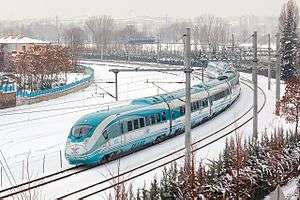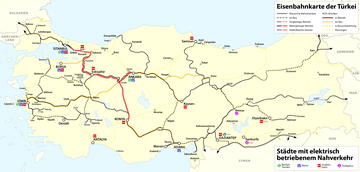High-speed rail in Turkey
The Turkish State Railways (TCDD) started building high-speed rail lines in 2003. TCDD has branded its high-speed service as Yüksek Hızlı Tren (YHT) which currently operates on two lines: the Ankara–Istanbul high-speed railway and the Ankara–Konya high-speed railway. YHT is the only high-speed rail service in Turkey, with two types of EMU train models operating at speeds of up to 250 km/h (HT65000)[1] or 300 km/h (HT80000).[2][3]
| High-speed rail in Turkey | |||||||||||||||||||||||||||||||||||||||||||||||||||||||||||||||||||||||||||||||||||||||||||||||||||||||||||||||||||||||||||||||||||||||||||||||||||||||||||||||||||||||||||||||||||||||||||||||||||||||||||||||||||||||||||||||||||||||||||||||||||||||||||||||||||||||||||||||||||||||||||||||||||||||||||||||
|---|---|---|---|---|---|---|---|---|---|---|---|---|---|---|---|---|---|---|---|---|---|---|---|---|---|---|---|---|---|---|---|---|---|---|---|---|---|---|---|---|---|---|---|---|---|---|---|---|---|---|---|---|---|---|---|---|---|---|---|---|---|---|---|---|---|---|---|---|---|---|---|---|---|---|---|---|---|---|---|---|---|---|---|---|---|---|---|---|---|---|---|---|---|---|---|---|---|---|---|---|---|---|---|---|---|---|---|---|---|---|---|---|---|---|---|---|---|---|---|---|---|---|---|---|---|---|---|---|---|---|---|---|---|---|---|---|---|---|---|---|---|---|---|---|---|---|---|---|---|---|---|---|---|---|---|---|---|---|---|---|---|---|---|---|---|---|---|---|---|---|---|---|---|---|---|---|---|---|---|---|---|---|---|---|---|---|---|---|---|---|---|---|---|---|---|---|---|---|---|---|---|---|---|---|---|---|---|---|---|---|---|---|---|---|---|---|---|---|---|---|---|---|---|---|---|---|---|---|---|---|---|---|---|---|---|---|---|---|---|---|---|---|---|---|---|---|---|---|---|---|---|---|---|---|---|---|---|---|---|---|---|---|---|---|---|---|---|---|---|---|---|---|---|---|---|---|---|---|---|---|---|---|---|---|---|---|---|---|---|---|---|---|---|---|---|---|---|---|---|---|---|---|---|
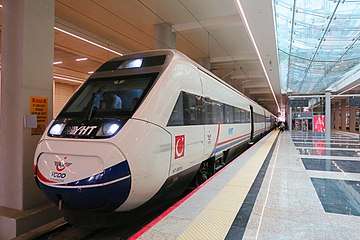 | |||||||||||||||||||||||||||||||||||||||||||||||||||||||||||||||||||||||||||||||||||||||||||||||||||||||||||||||||||||||||||||||||||||||||||||||||||||||||||||||||||||||||||||||||||||||||||||||||||||||||||||||||||||||||||||||||||||||||||||||||||||||||||||||||||||||||||||||||||||||||||||||||||||||||||||||
| System length | |||||||||||||||||||||||||||||||||||||||||||||||||||||||||||||||||||||||||||||||||||||||||||||||||||||||||||||||||||||||||||||||||||||||||||||||||||||||||||||||||||||||||||||||||||||||||||||||||||||||||||||||||||||||||||||||||||||||||||||||||||||||||||||||||||||||||||||||||||||||||||||||||||||||||||||||
| Double track | 745 km | ||||||||||||||||||||||||||||||||||||||||||||||||||||||||||||||||||||||||||||||||||||||||||||||||||||||||||||||||||||||||||||||||||||||||||||||||||||||||||||||||||||||||||||||||||||||||||||||||||||||||||||||||||||||||||||||||||||||||||||||||||||||||||||||||||||||||||||||||||||||||||||||||||||||||||||||
| Track gauge | |||||||||||||||||||||||||||||||||||||||||||||||||||||||||||||||||||||||||||||||||||||||||||||||||||||||||||||||||||||||||||||||||||||||||||||||||||||||||||||||||||||||||||||||||||||||||||||||||||||||||||||||||||||||||||||||||||||||||||||||||||||||||||||||||||||||||||||||||||||||||||||||||||||||||||||||
| Main | 1435 mm | ||||||||||||||||||||||||||||||||||||||||||||||||||||||||||||||||||||||||||||||||||||||||||||||||||||||||||||||||||||||||||||||||||||||||||||||||||||||||||||||||||||||||||||||||||||||||||||||||||||||||||||||||||||||||||||||||||||||||||||||||||||||||||||||||||||||||||||||||||||||||||||||||||||||||||||||
| Electrification | |||||||||||||||||||||||||||||||||||||||||||||||||||||||||||||||||||||||||||||||||||||||||||||||||||||||||||||||||||||||||||||||||||||||||||||||||||||||||||||||||||||||||||||||||||||||||||||||||||||||||||||||||||||||||||||||||||||||||||||||||||||||||||||||||||||||||||||||||||||||||||||||||||||||||||||||
| Main | 25 kv / 50 Hz | ||||||||||||||||||||||||||||||||||||||||||||||||||||||||||||||||||||||||||||||||||||||||||||||||||||||||||||||||||||||||||||||||||||||||||||||||||||||||||||||||||||||||||||||||||||||||||||||||||||||||||||||||||||||||||||||||||||||||||||||||||||||||||||||||||||||||||||||||||||||||||||||||||||||||||||||
| Minimum radius | 3,500 m (11,500 ft) | ||||||||||||||||||||||||||||||||||||||||||||||||||||||||||||||||||||||||||||||||||||||||||||||||||||||||||||||||||||||||||||||||||||||||||||||||||||||||||||||||||||||||||||||||||||||||||||||||||||||||||||||||||||||||||||||||||||||||||||||||||||||||||||||||||||||||||||||||||||||||||||||||||||||||||||||
| |||||||||||||||||||||||||||||||||||||||||||||||||||||||||||||||||||||||||||||||||||||||||||||||||||||||||||||||||||||||||||||||||||||||||||||||||||||||||||||||||||||||||||||||||||||||||||||||||||||||||||||||||||||||||||||||||||||||||||||||||||||||||||||||||||||||||||||||||||||||||||||||||||||||||||||||
On 13 March 2009, the first phase of the Ankara–Istanbul high-speed railway entered service between Ankara and Eskişehir. On 25 July 2014, the Ankara-Istanbul high-speed railway services began to reach the Pendik railway station on the Asian side of Istanbul,[4] and on 13 March 2019 the services began to reach the Halkalı railway station on the European side of Istanbul, passing through the Marmaray railway tunnel under the Bosphorus strait. There were initially 6 daily departures in both directions.[5]
On 23 August 2011, the YHT service on the Ankara–Konya high-speed railway was inaugurated.
High-speed rail in Turkey is still developing, with new lines currently under construction or in the planning phase. By 2023, the Ministry of Transport and Infrastructure expects Turkey's high-speed rail system to increase to 10,000 kilometers.[6]
Engineering
All high-speed railways being constructed in Turkey are double tracked, electrified, without level crossing, having ETCS signalization and meeting ATS, ERTMS, ATMS, SICAS and ATP standards.[7]
Lines in operation
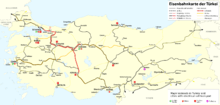
Ankara–İstanbul high-speed line
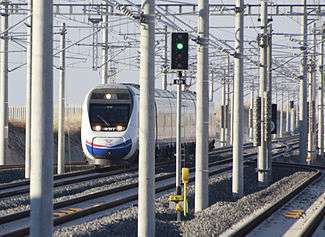
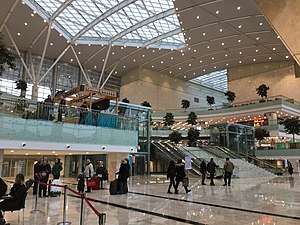
Prior to the introduction of the high-speed line, the population centres of İstanbul (14 million) and Ankara (5 million) were connected by a 576 km long railway line, of which only 110 km was double tracked.[8] The whole line was electrified, but low radius turns and poor track quality made high-speed rail transport impossible. Prior to the upgrading of this line in 2006, the railway's market share of Istanbul–Ankara passenger transit was 10%, with a travel time of ~6.5 hours.[8]
In 1994, an initial plan to upgrade the existing line was launched, named the "Ankara–İstanbul Railway Line Rehabilitation Project." Smoothing of curves to allow running at around 100 km/h, and some track doubling were planned.[9] The design specifications were not expected to meet future needs and no progress was made until 1999, when funding was obtained for a line between Esenkent and Eskişehir, to be operated at 200 km/h. Subsequently, this developed into the high-speed line project with the expected line speed raised to 250 km/h. Contracts for this line were signed in 2000.[9]
The development of the 1994 "railway rehabilitation project" forms the first section of the Ankara–İstanbul high-speed line, and is expected to reduce in half the travelling time between the two cities, with hopes to capture a far greater share (78%) of the passenger transportation market between the two cities.[10]
The China Railway Construction Corporation and China National Machinery Import and Export Corporation won the bid in 2005 to build the railway line in partnership with two Turkish companies, Cengiz Construction and İbrahim Cecen Ictas Construction.[11]
The Ankara–Istanbul HST line opened on 25 July 2014, although with all trains terminating at Pendik, which is 1 hour by bus from Kadikoy in the eastern suburbs of Istanbul. There are 12 trips per day and the journey takes 3.5 hours. All trains stop at Eskişehir and İzmit. High-speed trains were originally expected to start running through the Bosphorus tunnel to the European side of Istanbul in 2015 via Marmaray, but the work has been delayed and this is now likely to take at least until 2018.
Design and construction
The first high-speed railroad built in Turkey connects the county's largest metropolises, Ankara the capital and conurbation of İstanbul via Eskişehir, with a junction at Polatlı to the Ankara-Konya high-speed line.[12]
The line is 533 km long, double tracked, electrified, and signalled,[12] to ETCS level 1 standard[10][13] and is independent of the original Ankara to Istanbul line. The design speed is 250 km/h.[12]
The first part of the line to be constructed (Phase 1) was the Ankara–Eskişehir section, specifically between Sincan and İnönü, scheduled to open in 2006.
The second phase was scheduled to open in 2008 and included more difficult terrain which covers the path between İnönü and Köseköy, extending to Gebze close to Istanbul.[10] The service in this line is expected to start on 25 July 2014.[14] A part of the route has not been completed yet by the time of opening, so conventional line will be used until the completion of the project.
| Line section | Length (km) | Start / opening date[note 1] | Notes |
|---|---|---|---|
| Ankara–Sincan | 24 | As of 2009, the existing track between Ankara and Esenkent is used until the completion of a dedicated high-speed line[15]
As of 2013, one track of high-speed line has been completed between Ankara and Sincan and it is being used with reduced signalling features | |
| Sincan–Esenkent | 15 | 2008–2010[12] | This section has been opened in 2010 with full signalling features |
| Esenkent–Eskişehir | 206 | 2004–2009[15] | Infrastructure includes: 2 road bridges and 30 road underpasses, 7 railway bridges, and 13 river crossings. 4 viaducts (total length over 4 km), and 1 tunnel (471 m). First test runs in April 2007.[12] |
| Eskişehir station | 3.4 km | 2008–[12] | To avoid congestion problems in the city of Eskişehir, a tunnel and cutting project is being undertaken. 2240 m of covered tunnel consisting of 2 high-speed lines, 2 conventional lines, and 1 freight line, plus 1151 m of excavated track (U shape) with 2 high-speed tracks and 1 freight track.[12]
Eskisehir station infrastructure works have already started |
| Eskişehir–Inönü | 30 | Officially opened on 25 July 2014.[16] | |
| Inönü–Vezirhan | 54 | Officially opened on 25 July 2014.[16] | |
| Vezirhan–Köseköy | 104 | Officially opened on 25 July 2014.[16] | |
| Köseköy–Pendik | 56 | Officially opened on 25 July 2014.[16] | |
| Pendik–Haydarpaşa (İstanbul) | 44 | The final section of the track from Pendik to İstanbul falls within the scope of the Marmaray project, projected to open in March 2019. |
Operation and rolling stock
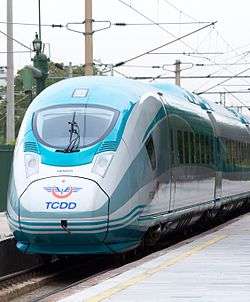
The Ankara to Eskişehir section officially opened on 13 March 2009.[15]
The line is operated by the Turkish State Railways, using the TCDD HT65000 six-car train sets constructed by the Construcciones y Auxiliar de Ferrocarriles (CAF) of Spain.
On 13 November 2009, a high-speed train derailed near Eskişehir.[17]
On 25 July 2014, Istanbul–Ankara high-speed train service started.[18] The stretch has not completed yet, thus service is partially using conventional line, which causes a little longer trip than the target. 8 trains depart every day in both directions.[19] Final station in İstanbul is temporarily Pendik, a district in east of İstanbul. Several public-transport connections are organized to access the HST trains.[20]
In addition to 11 sets of CAF used in Ankara–Eskişehir and Ankara–Konya routes, TCDD had bought seven Siemens Velaro sets for the Ankara–İstanbul line, open by the end of 2013.[21]
TCDD had also opened a new tender for 106 new sets to be supplied in 5 years and used in new-added lines.[22] This tender was cancelled and redone in 2018.
Ankara–Konya high-speed line
The second high-speed line construction project in Turkey was a line from Polatlı on the Ankara to İstanbul line to Konya.[23]
Prior to the construction of the line, journeys between Ankara and Konya took over 10 hours, travelling from Ankara via Eskişehir and Afyon, with a total length of nearly 1000 km.[9][note 2] The new high-speed line is 306 km in length, with a journey time of 1 hour and 15 minutes.[9] 212 km of new track is constructed via Polatlı and Konya, with a design permitting up to 350 km/h of high-speed rail transport.[23] ETCS Level 2 will be used.[24]
Construction was split into two phases: Phase 1 was the 100 km section and Phase 2 was the 112 km section between Polatlı and Konya.
| Line section | Length (km) | Start / opening date[note 1] | Notes |
|---|---|---|---|
| Ankara–Polatlı junction | 98 km | 2004–2009 | Constructed as part of the Ankara to Istanbul high-speed line, on the Sincan – Eskişehir section |
| Phase 1 Polatlı via Kocahacılı to the 100 km mark |
100 km | 2007–2011 | An estimated cost increase of 20% due to weak ground[23] |
| Phase 2 from 100 km mark to Konya |
112 km | 2006–2011 |
The line includes a tunnel of 2030m.[23] The first test train ran in December 2010;[25] Revenue services began on 24 August 2011.[26] Currently, same CAF trains which are used on Ankara–Eskisehir line are running on this line with 250 km/h maximum speed. In the future, TCDD will procure 6 more sets with up to 350 km/h. The journey time between the two cities (Ankara–Konya) is 1 and a half hours, dropping to 1 hour and 15 minutes in the future. Previously the journey time was 10 hours and 30 minutes. There are 10 trains a day, though this will rise to one per hour in the future.
Lines under construction and planning phase
Ankara–Sivas high-speed line
More than half of the budgeted investment has been done by 2014, and is planned to open in mid-2020. [27]
Prior to the construction of the high-speed line, the railway line length between Ankara and Sivas was 602 km, primarily single-tracked, with a travel time of 12 hours. New travel time will be 2 hours and 51 minutes[23] The new high-speed line will be double-tracked and have a length of 465 km eastwards from Ankara to Sivas[23] via Kırıkkale, Yerköy and Yozgat[28] and constructed for the most part to the same 250 km/h operational design as the previous lines. The infrastructure includes 6 viaducts (with a total length over 3 km), 11 tunnels (including one of ~3 km in length), and 67 bridges.[29] A 2019 update predicted service in 2022, 3 years behind schedule due to "geographic difficulties",[30] but the now has returned to the prior opening date of 2020 summer.[31]
The route study was completed by the end of 2006, and put up for tender in two parts; separated at the 174 km mark from Ankara at Yerköy.[29]
| Line section | Length (km) | Start / opening date[note 1] | Notes |
|---|---|---|---|
| Ankara–Kırıkkale | 88 | 2013 – April 2018 | Plans are revised due to that previous plans includes short sections of less than high-speed running due to small radius curve sections of track in the Ankara to Kırıkkkale section.[29] |
| Kırıkkale–Yerköy | 86 | 2013 – April 2019 | Tender is completed in 2012. |
| Yerköy–Sivas | 291 | 2009[32]-2022 (estimated) | 7 tunnels over 10 km in total length and 4 viaducts over 2.7 km in total length. Tender for construction of groundwork awarded in 2008. 7 stations to be built: 3 between Yerköy and Doğakent, and 4 between Doğakent and Sivas, to be separately tendered.[29] |
Sivas–Kars line
An extension eastwards to Kars from the Ankara – Sivas line is planned (a feasibility study done in 2006[33]), passing through Erzincan and Erzurum.[28] The line is expected to be built in three phases. It will be electrified and double-tracked based on the 250 km/h standard.[34]
Ankara–İzmir high-speed line
The project has recently started, and was originally planned to be completed by the summer of 2020.[31]
The line will pass through Afyon to meet the high-speed line from Ankara to Istanbul near Polatlı. It will have a length of 624 km, with a projected running speed of 250 km/h[34] The travel will take 3 hours and 30 minutes.
The line is scheduled to be finished and operational by 2020.
The construction of line is planned in three phases:
| Line section | Length (km) | Start / opening date[note 1] | Notes |
|---|---|---|---|
| Ankara–Polatlı junction | 98 | 2004–2009/prior work | Constructed as part of the Ankara to Istanbul high-speed line, on the Sincan – Eskişehir section. |
| Polatlı–Konya the 120 km mark |
27 | 2007–2011/prior work | Constructed as part of the Ankara to Konya high-speed line, on the Phase1 section. |
| Phase 1 Polatlı–Afyon |
167 | 2016-2018 | The line uses first 120 km. of Ankara – Konya high-speed line. The junction is located approximately 20 km south of Polatlı.
Number of tunnels: 11 --- Total tunnel length: 8.000 Meters |
| Phase 2 Afyon–Uşak |
2018-2019 | tendered in 2017. | |
| Phase 3 Uşak–Manisa–İzmir |
2019-2020 | Plans are being revised. |
Ankara–Bursa high-speed line
A 75 km line between Bursa and Bozüyük is planned to connect with the Ankara–Istanbul high-speed line; contracts were awarded in 2011 and construction is expected to start in 2012. The line is expected to open in 2023, and would be capable of 250 km/h operation.[35]
| Line section | Length (km) | Start / opening date[note 1] | Notes |
|---|---|---|---|
| Bursa-Yenişehir | 2012–2015 (estimated) | ||
| Yenisehir–Bozüyük |
One third of the budgeted investment has been done, and is planned to be completed by 2020.
For high-speed trains, TCDD has a budget of more than 1 billion TL for 2014.[36]
According to official (budgeted) and unofficial (announced) plans, 45 of 81 provincial seats will be connected by high speed services in the long term.[37]
Lines in the planning phase
Antalya–Konya–Kayseri high-speed line
This line is planned as a section of the Ankara–Antalya high-speed line. The line will used for Ankara–Antalya high-speed line.
İstanbul–Edirne–Kapıkule–Svilengrad (Bulgaria) high-speed line
The Ankara to Istanbul high-speed line is to be extended 230 km from Halkalı (a western suburb of Istanbul) all the way to Turkey's borders with Bulgaria and Greece at the vicinity of Kapıkule in the Edirne Province. Travel times will be reduced from 5 hours to 1 hour assuming non-stop journey between Istanbul terminus and the border post.
Construction began in 2019 and is expected to be finished by 2022.[38]
Ankara–Kayseri high-speed line
Kayseri–Yerköy line – branching from the Ankara–Sivas high-speed line.
Future extension plans
Other projected high-speed rail lines include:
- Eskişehir-Afyon-Antalya line
- Ordu-Samsun-Çorum-Kırıkkale-Ankara line
High-speed train sets and production facilities
TREVI ETR 500 test trains
The first high-speed trains to run on Turkish rails were two ETR 500 train sets rented from Trenitalia of Italy and were used for testing the completed part of the high-speed railway network, between Eskişehir and Ankara, on 23 April 2007.[39] During the tests, ETR 500 Y2 achieved the current rail speed record in Turkey, reaching 303 km/h.[40]
CAF TCDD HT65000
The Turkish State Railways agreed with Construcciones y Auxiliar de Ferrocarriles (CAF), a Spanish rail car building company, to design a high-speed train set in 2006. CAF introduced the HT65000 EMU sets, similar to the RENFE Class 120 / 121 EMUs. The HT65000 is a 6 car EMU set using 25 kV AC electrical system via a pantograph. These sets have an acceleration of 0.48 m/s² and the power output is 4,800 kW.[41] One train set has a capacity of 411 passengers, as 365 passengers in Economy class and 55 passengers in business class (or 1st class).[7]TCDD ordered 10 sets of HT65000 EMUs. The first set left Spain on 10 November 2007 and arrived in Turkey at Kapıkule on 20 November 2007.[42] Then 4 more sets came to Turkey in 2008, 3 more in 2009 and 2 more in 2010.
Siemens Velaro TR
The Velaro TR (TCDD HT80000) is a Velaro D derived 8-car standard gauge high-speed train for the Turkish State Railways (TCDD).[43] The eight cars, totalling a length of 200 m, can accommodate 519 passengers and reach a top speed of 300 km/h.[2][3] 25 kV 50 Hz AC power the train with a total of 8 MW.[43]
Turkish State Railways (TCDD) placed an order for seven Velaro high-speed trainsets in July 2013.[44] The contract is worth €285M, including seven years of maintenance.[44] The Velaros are to be deployed on the Turkish high-speed railway network. The first Siemens Velaro TR entered service in 2014.[45]
On 18 February 2015, TCDD ordered another 10 Velaro TR for delivery in 2017.[46] The €400M contract include the first three years of maintenance and spareparts.
Unlike the traditional white – red – dark blue color scheme used on the TCDD HT65000 high-speed trains, a white – turquoise – grey color scheme has been selected for the livery of TCDD's Velaro TR trains.[45]
EUROTEM
EUROTEM, alternatively Hyundai EURotem, is a joint enterprise between Hyundai Rotem of South Korea and TÜVASAŞ of Turkey which was established in 2006[47] and started production in December 2007.[47] The Hyundai EURotem factory in Adapazarı, Turkey, was built as the Hızlı Tren Fabrikası (High-Speed Train Factory) with the purpose of manufacturing the next generation of Turkey's high-speed train sets.[48]
Ridership
| Year | million riders | ±% p.a. |
|---|---|---|
| 2011 | 2.56 | — |
| 2012 | 3.35 | +30.86% |
| 2013 | 4.21 | +25.67% |
| 2014 | 5.09 | +20.90% |
| 2015 | 5.69 | +11.79% |
| 2016 | 5.9 | +3.69% |
| 2017 | 7.1 | +20.34% |
| 2018 | 8.1 | +14.08% |
| 2019 | 8.3 | +2.47% |
| Source: [49][50][51] | ||
Until 2015 Ridership had grown at the expense of TCDD's regular train services and has not dented air traffic demand. Total TCDD services incl. HSR remain flat.[49] Traffic is was affected since 2012 all services to Istanbul were suspended. A sharp increase in ridership occurred after extra high speed trains started operation. A further increase in 2018 and 2019 is expected with new trainsets becoming operational and the opening of the Istanbul terminals Halkali and Haydarpasa.[50]
Related infrastructure projects
The Marmaray project, which consists of a rail transport network around Istanbul and the world's deepest immersed tube railway tunnel under the Bosphorus strait, is also under construction. The Marmaray tunnel will connect the railway lines on the European and Asian parts of Istanbul and Turkey. In 2013 the Marmaray tunnel was opened and passenger transportation is started partially in 13.5 km of total 76.5 km.[52] The rest was expected to be completed by 2015, but it now looks like this will not happen until some time in 2016. The project connecting the European and Asian suburban railway lines, will also connect the Thracian and Anatolian high-speed railway lines in Turkey via the world's deepest immersed-tube railway tunnel across the Bosphorus strait.[53]
A new high-speed rail terminus station is to be built in Ankara (2009–2010), which is to be funded as a public–private partnership, using the Build-Operate-Transfer model. Additionally, new stations are to be constructed in İstanbul, Izmir, Edirne, Trabzon, Erzurum, Erzincan, Sivas, Kayseri, Antalya, Afyon and Polatlı.[54] Furthermore, an additional project called Başkentray is also underway which consist of the renewal of railways in the urban section of Ankara.
See also
- Turkish State Railways
- Rail transport in Turkey
- History of rail transport in Turkey
- Ankara–Istanbul high-speed railway
- Ankara–Konya high-speed railway
Notes and references
Notes
- Start of construction / Official opening
- There was no direct connection between Ankara and Konya by rail
References
- "Technical specifications of TCDD HT65000". CAF. Retrieved 15 July 2016.
- "Velaro Turkey: High-Speed Train for TCDD" (PDF). Siemens Mobility. Retrieved 16 April 2020.
- "Velaro Turkey High-Speed Train". Siemens Mobility. Retrieved 16 April 2020.
- Uysal, Onur. "First High Speed Train Set on Ankara Istanbul Line Arrived Istanbul", Rail Turkey, 26 July 2014
- Uysal, Onur. "New Schedule for Istanbul-Ankara High Speed Train", Rail Turkey, 9 August 2014
- Turkey's high-speed rail system will be complete by 2023 – rayturk.net
- YHT Tanıtım Kitabi (YHT Reference Book), published by TCDD and Turkish Ministry of Transport.
- Evaluation of Ankara – Istanbul high speed train project Authors: Ali Payidar Akgungor, Abdulmuttalip Demirel, 2006, ISSN 1648-4142 print / ISSN 1648-3480 online, periodical: "TRANSPORT" 2007, Vol XXII, No 1, www.transport.vgtu.lt
- Railway projects in Turkey Archived 14 July 2011 at the Wayback Machine Author: Mustafa Karaşahin, Publication: "Mechanics Transport Communications", ISSN 1312-3823, issue 3, 2007 ww.mtc-aj.com
- Ankara-İstanbul High-Speed Train Project, Turkey railway-technology.com
- http://sinosphere.blogs.nytimes.com/2014/07/28/china-exports-high-speed-rail-technology-to-turkey/?_php=true&_type=blogs&_r=0
- The current situation in the Ankara–İstanbul high-speed line project Archived 28 April 2009 at the Wayback Machine www.tcdd.gov.tr "Ankara–İstanbul high-speed line project"
- Alcatel-Lucent partners with Thales to expand Turkish Railways’ high-speed signalling network 16 March 2009 www.alcatel-lucent.com
- Uysal, Onur. "Istanbul–Ankara High Speed Train to Start on 25th of July", Rail Turkey, 21 July 2014
- UIC celebrates the introduction of high speed in Turkey Archived 20 July 2011 at the Wayback Machine 19 March 2009 uic.asso.fr
- Ozen, Levent. "Sections of Ankara Istanbul HST Line", RaillyNews, 25 July 2014
- Turkey high-speed train derails 13 November 2009 news.bbc.co.uk
- Uysal, Onur. "First High Speed Train Set on Ankara Istanbul Line Arrived İstanbul", Rail Turkey, 26 July 2014
- http://www.tcddtasimacilik.gov.tr/files/3/yolcu/0504yht.pdf, TCDDT, 3 May 2018 Archived 12 July 2018 at the Wayback Machine
- Uysal, Onur. "How to Get to High Speed Train in İstanbul?", Rail Turkey, 22 October 2014
- Uysal, Onur. "TCDD Prefers Velaro as HST Sets", Rail Turkey, 9 July 2013
- Uysal, Onur. "Turkey to Buy 106 New High Speed Trains", Rail Turkey, 28 July 2013
- The current situation on the Ankara–Konya high-speed line www.tcdd.gov.tr
- "Railway Gazette: First ETCS Level 2 contract awarded in Turkey". Retrieved 13 February 2011.
- "Railway Gazette: Completion of Ankara – Konya high speed line is significant step". 24 December 2010. Retrieved 24 December 2010.
- Opening of Ankara – Konya fast line completes strategic link – Railway Gazette
- "Testing underway on Ankara – Sivas high speed line". Railway Gazette International. 9 March 2020. Retrieved 14 May 2020.
- Turkey’s Railway Stations: A railway station that connects the Black Sea to the Mediterranean: Sivas Railway Station Archived 4 September 2011 at the Wayback Machine www.arkas.com.tr
- ANKARA-SİVAS HIZLI TREN PROJESİ YERKÖY-YOZGAT-SİVAS KESİMİ Archived 6 January 2010 at the Wayback Machine Ankara – Sivas railway project www.tcdd.gov.tr
- https://raillynews.com/2019/02/erdogan-ankara-sivas-yht-line-also-yozgatin-project/
- www.raillynews.com https://www.raillynews.com/2020/01/ankara-sivas-high-speed-train-project-has-been-completed/. Retrieved 5 March 2020. Missing or empty
|title=(help) - SİVAS ANKARA ARASI 2 SAAT 50 DAKİKAYA İNECEK "2hr 50mins between Ankara and Sivas" 16 March 2009 sipastv.com
- SİVAS – ERZİNCAN – ERZURUM- KARS DEMİRYOLU PROJESİ SİVAS – ERZİNCAN – ERZURUM – KARS RAILWAY PROJECT www.dlh.gov.tr
- Development of Euro-Asian transport links Author: Selim Bolat, Research, Planning & Coordination Department, Turkish State Railways –TCDD, September 2007, Page 4, via www.unece.org
- "High speed line to Bursa to open by 2015". Railway Gazette International. Retrieved 5 January 2012.
- Uysal, Onur. "Railway Investments of Turkey in 2014", Rail Turkey, 21 January 2014
- Uysal, Onur. "Cities To Be Connected by High Speed Trains in Turkey", Rail Turkey, 7 May 2014
- "Halkali-Kapikule railway breaks ground". KHL Group. October 2019. Retrieved 14 May 2020.
- Hürriyet: Hızlı tren artık raylarda
- "Nuovo record di velocità del treno italiano Etr 500 in Turchia: 303 km/h" (in Italian). Il Sole 24 Ore. 14 September 2007. Retrieved 11 November 2012.
- TCDD HT65000 Page Archived 27 February 2008 at the Wayback Machine - Information on the HT65000
- TCDD English Site Archived 27 February 2008 at the Wayback Machine - First High Speed Train set arrived in Turkey
- "Velaro Turkey High-Speed Train" (PDF). Mobility.siemens.com. Retrieved 20 June 2015.
- "Turkey orders Siemens Velaro high speed trainsets". Railway Gazette International. 8 July 2013.
- "TCDD's first Siemens Velaro train set at the Ankara Central Station". Archived from the original on 13 October 2016. Retrieved 21 June 2016.
- "TCDD orders 10 more Velaros". Railway Gazette International. 18 February 2015.
- Presentation of the Rail Transport – Turkey Archived 3 March 2011 at WebCite Tevfik Muhammed YEŞİLÇAM (TCDD) 21 November 2008 Page 29, www.euromedtransport.org
- TCDD: Hızlı Tren Fabrikası (High-Speed Train Factory)
- "Every one of four traveled fast".
- "Passenger Transportation by rail on the rise".
- "Turkish railways posts record figures for 2019"".
- Uysal, Onur. "Marmaray Opened", Rail Turkey, 29 October 2013
- Project of the Century: Marmaray www.tcdd.gov.tr
- Privatizations & Upcoming PPP-Projects in Turkey Page 28 www.joi.or.jp
- Emergency dropoffs only; the station has no building infrastructure and no place to rebuild.
